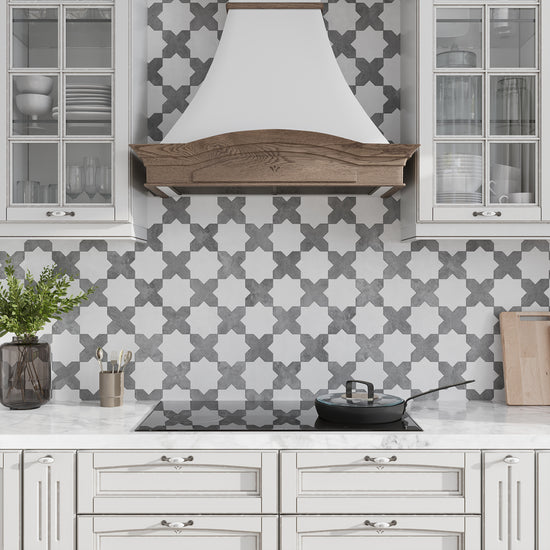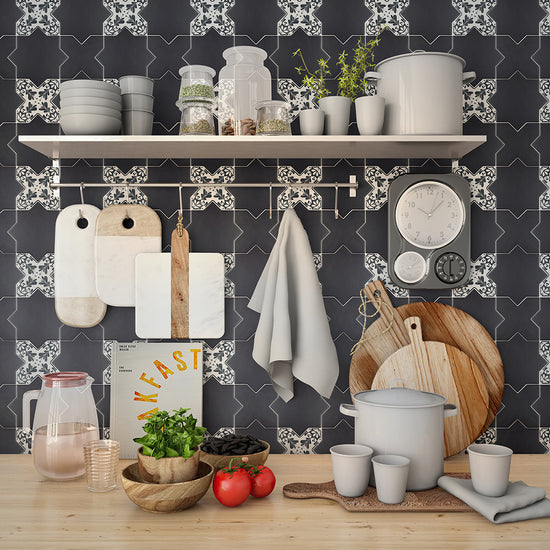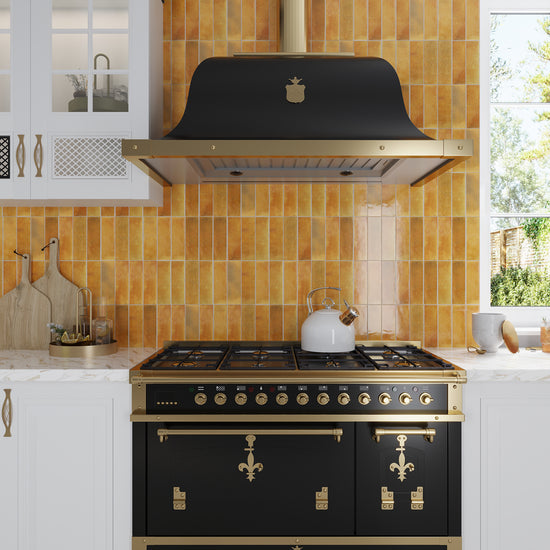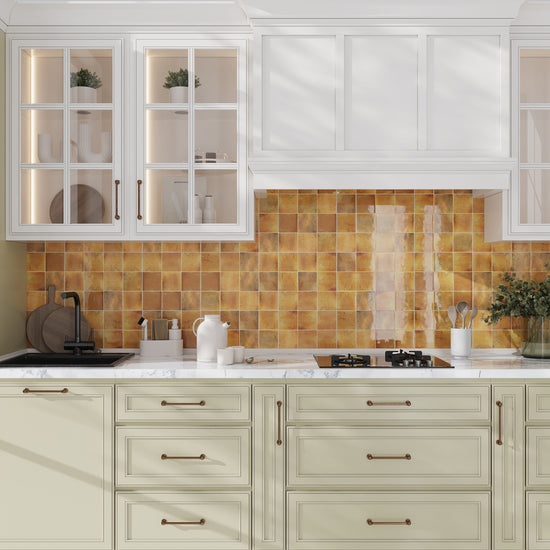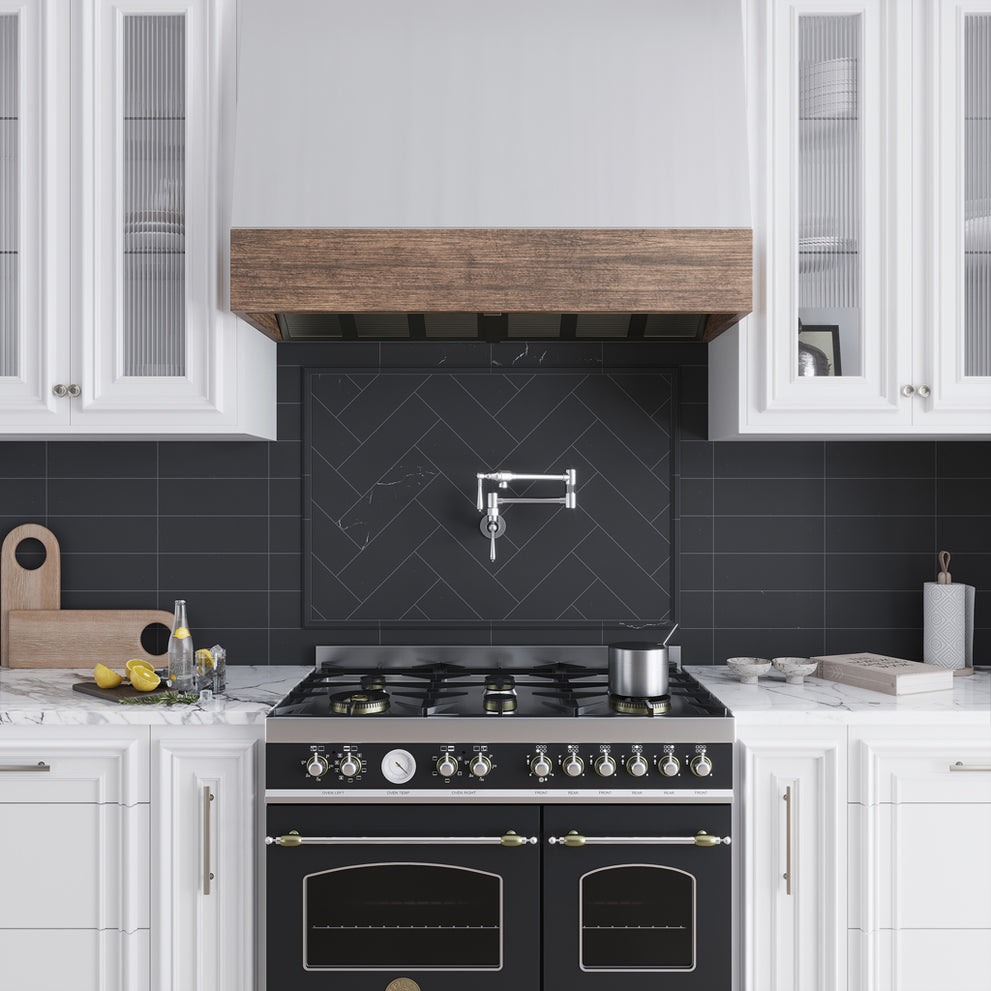A No Nonsense Guide to Choose the Perfect Kitchen Backsplash!
Nov 07, 2024The right backsplash tile can transform the hub of the home into a completely new space. But with a multitude of options available, finding the perfect match for your kitchen can be a daunting task. Fret not! In this blog post, we answer the question “how to choose kitchen backsplash tile?”
A tiled backsplash is the hero of the busiest areas in the home. It adds to the room's aesthetic appeal while protecting walls from everyday messes. Ahead, we cover everything you need to know about this vertical cladding, including tips on choosing a kitchen backsplash tile, small and large sizes, finishes available, and the right grout color for your tilework.
Tips for Choosing the Perfect Kitchen Backsplash
If you're wondering how to pick a kitchen backsplash tile suitable for your space, here are a few things to keep top of mind:
Understand material durability: Ceramic or glass tile? Perhaps porcelain or marble will hold up better in a moisture-prone area? The best tile backsplash for kitchen is durable, stain- and moisture-resistant, and easy to keep clean.
Consider style and design: How do you pick a trendy backsplash material that complements your culinary space? Consider the room's overall aesthetic. What kitchen backsplash colors and patterns resonate with your taste? If you're after an elegant finish, marble tile might just be right up your alley. Or would you rather go for something subtle, bold, or modern?
Don't forget size and scale: In choosing between small and big tiles, take the size of the room into account. The last thing you want is a backsplash that overwhelms the kitchen space. Mosaic tiles, like our Beige 12-in x 12-in Polished Natural Stone Marble Mixed Patterned Floor and Wall Tile, are great for creating a detailed look that becomes the focal of the room. Large tile sizes lend a clean, uniform finish with fewer and tighter grout lines.
Cleaning and maintenance: When selecting the best kitchen backsplash tile, consider how easy it is to clean and maintain over a long period of time. Tiles generally require minimal upkeep, but more porous options like marble will need special care and regular sealing to protect against stains and moisture damage.
Order tile samples: At Apollo Tile, we have a sample service that allows you to purchase your favored tile before committing to a big order. This way, you can live with the tile for a while and experience quality and style firsthand. Tape the sample to the backsplash area to see how it works with all the other elements in the room and how it looks throughout the day as natural light changes.
Small, Medium, or Large Format Tiles for Kitchen Backsplash
Tile backsplash options can influence the perception of space. How do you then choose the right size and what effect do small, medium, and large tiles have?
1x1 mosaic tiles create an intricate design. They are fixed to mesh sheets measuring 12x12 inches for easy installation. These dainty tiles add plenty of decorative panache and texture to small kitchens without overwhelming the room.
3x6 subway tiles or 4x4 square tiles work well for both small and big backsplash areas. Case in point: our gorgeous Antiek 2.58 in. x 7.9 in. Glossy Orange Ceramic Subway Wall and Floor Tile and Antiek 3.94 in. x 3.94 in. Glossy Orange Ceramic Square Wall and Floor Tile .
Large tiles will sit well in an expansive kitchen with taller ceilings. They also complement sleek, modern cabinets with minimal hardware, thanks to their seamless, uncluttered design. With this said, you aren't obligated to forgo a bigger size if you have a not-so-big kitchen. Large-scale tiles can make a smaller room feel more spacious than it really is. In this case, opt for kitchen wall tile that's smaller than the floor tiles to maintain good proportion.
Match or Contrast: Decide on the Grout Color
Next, we look at how to choose kitchen backsplash grout color. Do you contrast or match grout to the color of your tilework? If you're after a bold statement, go for a contrasting grout color (for instance, white tile with black grout). This visual effect is a great way to highlight and draw attention to a tile design or pattern.
Matching grout or finding the closest shade to your kitchen backsplash tile color results in a subtle and cohesive appearance. If tiling a smaller room, you may want to match grout to tile, as too much of a contrast can overwhelm the space. Large-format tiles can also benefit from matching colors to maintain a uniform appearance that's suited for contemporary kitchens.
Understanding Tile Backsplash Finishes
Apart from color, shape, and size, tile finish is also an essential aspect of choosing a kitchen backsplash. It contributes to the overall appearance and ambiance of the room and can turn the walls of your culinary space into total bliss.
Glossy finish tile: As the name suggests, glossy tile has a shiny, glass-like layer that reflects natural light. It exudes an elegant flair that brings out contemporary appeal to the kitchen. A glossy finish is easy to clean and can make the room brighter and spacious.
Matte finish tile: In contrast to a glossy glaze, matte-finished tiles have an added layer that achieves a non-shiny look. If you fancy a subtle, natural aesthetic, then this backsplash finish is for you. Because it has a rather rough surface, matte tile tends to conceal dirt and marks better.
Honed finish tile: Soft and smooth, honed tiles feature an almost satin texture that's matte in style. It's a non-reflective, durable finish associated with natural stone tiles such as marble and travertine—perfect for a cozy and warm kitchen atmosphere.
Textured finish tile: For added depth and dimension, a textured kitchen backsplash is the way to go. This tile finish maintains the raw beauty of the material and lends tactile appeal to both traditional and modern settings.
Conclusion
The best kitchen backsplash ideas deliver great style versatility and can transform the room from ordinary to extraordinary. In answering the question “how to pick a backsplash,” planning out your space and researching the different tiling materials will enhance both the function and splendor of your interior. Check out some amazing kitchen backsplash ideas here to help you get started on your design.
FAQ
1. What kind of backsplash makes a kitchen look bigger?
Installing a lighter kitchen backsplash tile color adds a bright and airy ambiance. Tile with a reflective surface or a clean, uncluttered design also contributes to a spacious feel.
2. Which is better for a backsplash, porcelain or ceramic?
Both ceramic and porcelain tile are great options for the kitchen backsplash. They come in stunning designs to cater to different style preferences, can withstand daily spills and splatters, and are easy to clean and maintain.
3. Should the kitchen backsplash be dark or light?
This is a matter of personal preference. White and lighter kitchen backsplash colors add a pristine and bright touch to the room. They work well with both neutral and darker cabinets. Dark backsplash tiles can pull the room in and create an intimate setting. They contrast wonderfully with lighter cabinets and countertops.
4. Should backsplash tile sit on a countertop?
Sitting the tile right on the countertop can provide the cleanest, neatest transition. However, some manufacturers recommend leaving a 1/8" to 1/4" gap between the tile and countertop to allow for expansion and contraction during temperature changes. Caulk can be used as a water-resistant seal to fill this gap.
5. What tile size looks best as a kitchen backsplash?
The best tile size is one that's proportional to the size of the room. 3x6 subway tile in a brick pattern remains a sought-after choice for a classic finish. 12” x 12” mosaic sheets are a great option for a unique, intricate design. Large-format tiles create a seamless and expansive look.
6. Can I use mosaic tile for a kitchen backsplash?
Mosaic tiles are fantastic for the kitchen backsplash. They are available in different materials, colors, shapes, and finishes, and can turn any functional space into a centerpiece.
7. How do I measure backsplash tile for the kitchen?
Use a tape measure to find the width and height of the backsplash area. Multiply the results to get the total square inches. Note that tile is sold by the square foot. So, divide the total square inches by 144 to find the amount of square footage needed. We recommend investing in 15% extra products to cater for cuts, accidental damages, and future repairs.


